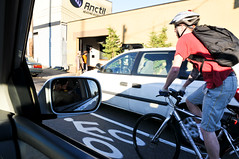
(Photo © J. Maus)
Tomorrow (yes, Saturday) is the first open house for the N. Williams Avenue Traffic Safety Operations Project. As the first open house for this extremely important project, it’s crucial that people show up and voice their support for bikeway improvements.
Currently, PBOT feels that the most important segment of Williams (the commercial district between Cook and Skidmore) has too much automobile traffic and parking demand (and too many businesses demanding it) to make a significant improvement to the bikeway.
The project was conceived because the soaring bike traffic on the street has outgrown the meager bike lane that exists there now. When they looked into the situation in advance of this project, PBOT realized the context of the traffic problems on this street went beyond bikes and they are now taking a holistic look at the street layout in an attempt to make it work better for everyone.
At this point, the SAC is trying to determine what the basic “floorplan” of the street should be. Before getting into specific intersection treatments, the elements they are trying to determine include; the number and width of vehicle lanes, whether or not to remove/maintain on-street car parking, and what type of bikeway facility to install (bike lanes, cycle-tracks, and so on).
Because lane configurations and land-use change throughout the corridor, the project consultant has broken the street into five distinct segments: Segment 1 from Weidler to the I-5 on-ramp; Segment 2 from I-5 on-ramp to Russell; Segment 3 from Russell to Cook; Segment 4 from Cook to Skidmore; and Segment 5 from Skidmore to Killingsworth.
According to a presentation available on the project website (PDF here), current proposals are to re-allocate vehicle lanes in four of the five segments in order to make more room for bus and bike operations.
However, in Segment 4 — which includes the dense commercial zone between Beech and Shaver — the current thinking is that, due to high motor vehicle traffic volumes and high parking demands, there would be no change to the current lane configuration.

Russ Willis, a citizen activist who has attended the SAC meetings, called Segment 4, “the eight hundred pound gorilla.” He was at the most recent meeting where current proposals were shared. “As has been noted,” he wrote on the Active Right of Way email list, “the plan thus far is pretty much to do nothing…”
Sources at the SAC tell us that business owners (Cha! Cha! Cha! being one of them) came to the last SAC meeting to make it clear they need as much parking and motor vehicle access as possible.
PBOT project manager Ellen Vanderslice says because the high traffic volume and demand for parking in Segment 4,
“The idea of taking away a traffic or parking lane as a first blush action doesn’t really work. If you do either of those things, the neighborhoods are just never going to support that.”
She continued,
“If we start with the premise that taking away the traffic lane would create traffic problems, given today’s traffic volumes and that taking away parking would create parking problems, then we’re sort of stuck. We’ve got those things in place, so what can we do to make it better?”
[It’s important to note that the high auto volume only occurs during a few hours in the PM peak.]
To make it better without altering the lane configurations, Vanderslice says PBOT is looking at ways to slow people down (31% of motor vehicles currently go over the speed limit in Segment 4) and to address the “dooring issue.”
To handle speed, the current thinking is to add traffic signals to the intersections at Cook, Beech and Failing streets. This would give PBOT six signals in a row and would allow them to essentially dictate speeds through signal timing technology (a.k.a. green wave). Of course, signals are expensive the current project doesn’t have the money for them, so if that’s the chosen route, PBOT would have to then find funding.
To address the dooring issue, Vanderslice said they’ll unveil a new bike lane striping method. Currently, all the lanes in Segment 4 are as narrow as they can be. So, the idea would be to widen the existing bike lane, but make it “advisory.”
“We’re toying with making a wider bike lane through there, and there really isn’t room, but we could make a wide bike lane that is advisory so that the [standard] travel lane is actually narrower than we’d allow [10-feet wide, which it is currently, is as narrow as PBOT will go on standard vehicle lanes]…”
The bike lane stripe would be dotted (not solid), which would allow people on bikes to use the full width when no auto traffic is present, but then cars would be able to essentially drive in the bike lane when no bikes are present (hence the term “advisory”).
Is it possible that PBOT is caving to an auto-centric status quo? Remember the “Green Transportation Hierarchy” as published in the Bike Plan for 2030? Does PBOT’s statements and proposals on this project jibe with this…

If you feel that untested bike lane striping methods and new signals that might never materialize aren’t enough on one of Portland’s busiest bikeways, than please show up Saturday to weigh in and help set the tone for a bikeway we can be proud of. Let’s give PBOT the backing they need to seriously consider one standard vehicle lane in Segment 4.
- Williams Project Open House Workshop
Saturday, April 16 – 1:30 to 4:00 p.m.
Immaculate Heart Church (2910 N Williams Ave)
Light snacks and licensed childcare will be provided



